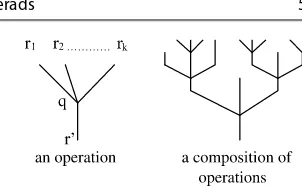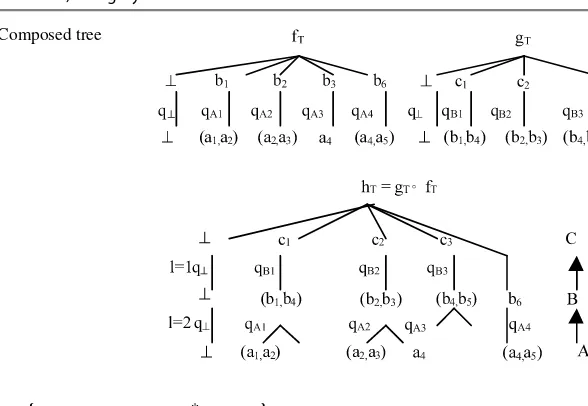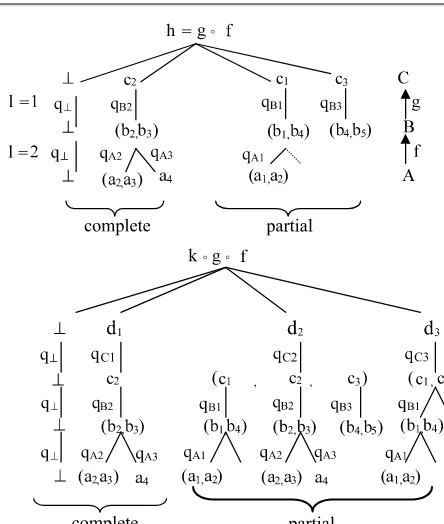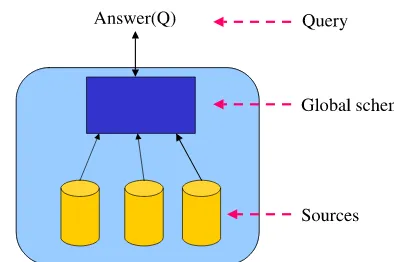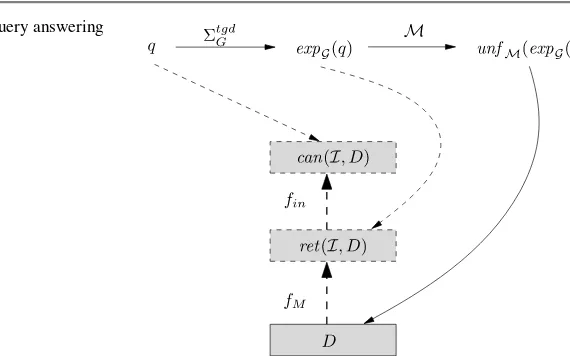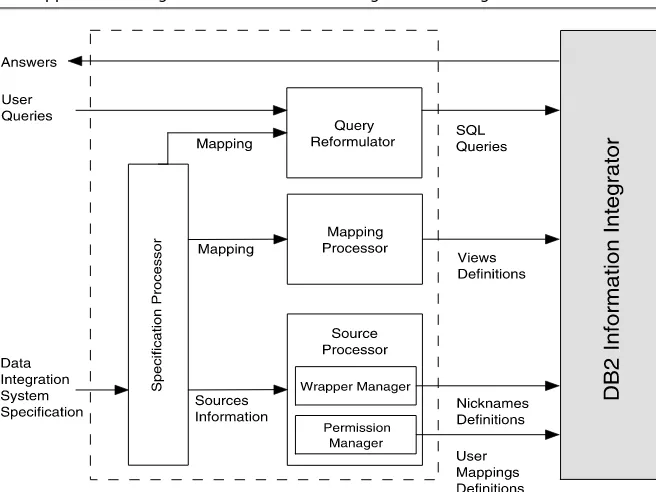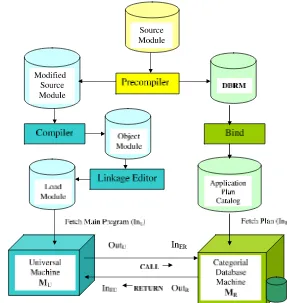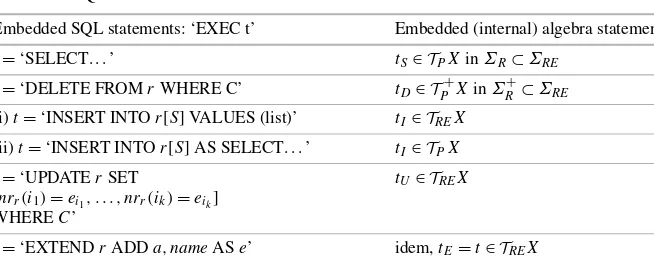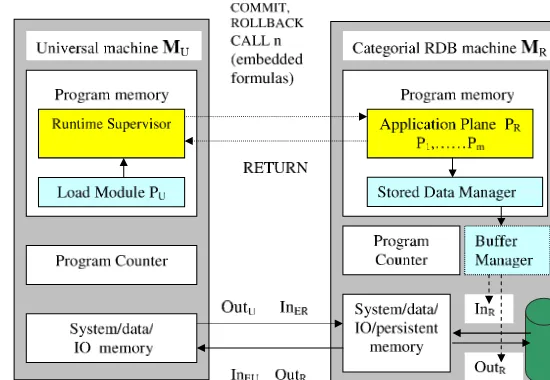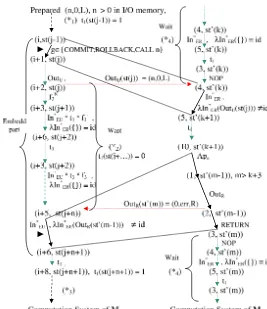Big Data
Integration
Theory
Zoran Majkić
Theory and Methods of Database
Editors David Gries Fred B. Schneider
For further volumes:
Zoran Majki´c
Big Data Integration
Theory
ISRST
Tallahassee, FL, USA
Series Editors David Gries
Department of Computer Science Cornell University
Ithaca, NY, USA
Fred B. Schneider
Department of Computer Science Cornell University
Ithaca, NY, USA
ISSN 1868-0941 ISSN 1868-095X (electronic) Texts in Computer Science
ISBN 978-3-319-04155-1 ISBN 978-3-319-04156-8 (eBook) DOI 10.1007/978-3-319-04156-8
Springer Cham Heidelberg New York Dordrecht London
Library of Congress Control Number: 2014931373
© Springer International Publishing Switzerland 2014
This work is subject to copyright. All rights are reserved by the Publisher, whether the whole or part of the material is concerned, specifically the rights of translation, reprinting, reuse of illustrations, recitation, broadcasting, reproduction on microfilms or in any other physical way, and transmission or information storage and retrieval, electronic adaptation, computer software, or by similar or dissimilar methodology now known or hereafter developed. Exempted from this legal reservation are brief excerpts in connection with reviews or scholarly analysis or material supplied specifically for the purpose of being entered and executed on a computer system, for exclusive use by the purchaser of the work. Duplication of this publication or parts thereof is permitted only under the provisions of the Copyright Law of the Publisher’s location, in its current version, and permission for use must always be obtained from Springer. Permissions for use may be obtained through RightsLink at the Copyright Clearance Center. Violations are liable to prosecution under the respective Copyright Law.
The use of general descriptive names, registered names, trademarks, service marks, etc. in this publication does not imply, even in the absence of a specific statement, that such names are exempt from the relevant protective laws and regulations and therefore free for general use.
While the advice and information in this book are believed to be true and accurate at the date of pub-lication, neither the authors nor the editors nor the publisher can accept any legal responsibility for any errors or omissions that may be made. The publisher makes no warranty, express or implied, with respect to the material contained herein.
Printed on acid-free paper
Big data is a popular term used to describe the exponential growth, availability and use of information, both structured and unstructured. Much has been written on the big data trend and how it can serve as the basis for innovation, differentiation and growth.
According to International Data Corporation (IDC) (one of the premier global providers of market intelligence, advisory services, and events for the information technology, telecommunications and consumer technology markets), it is imperative that organizations and IT leaders focus on the ever-increasing volume, variety and velocity of information that forms big data. From Internet sources, available to all riders, here I briefly cite most of them:
• Volume. Many factors contribute to the increase in data volume—transaction-based data stored through the years, text data constantly streaming in from social media, increasing amounts of sensor data being collected, etc. In the past, ex-cessive data volume created a storage issue. But with today’s decreasing storage costs, other issues emerge, including how to determine relevance amidst the large volumes of data and how to create value from data that is relevant.
• Variety. Data today comes in all types of formats—from traditional databases to hierarchical data stores created by end users and OLAP systems, to text docu-ments, email, meter-collected data, video, audio, stock ticker data and financial transactions.
• Velocity. According to Gartner, velocity means both how fast data is being pro-duced and how fast the data must be processed to meet demand. Reacting quickly enough to deal with velocity is a challenge to most organizations.
• Variability. In addition to the increasing velocities and varieties of data, data flows can be highly inconsistent with periodic peaks. Daily, seasonal and event-triggered peak data loads can be challenging to manage—especially with social media involved.
• Complexity. When you deal with huge volumes of data, it comes from mul-tiple sources. It is quite an undertaking to link, match, cleanse and transform data across systems. However, it is necessary to connect and correlate relation-ships, hierarchies and multiple data linkages or your data can quickly spiral out
of control. Data governance can help you determine how disparate data relates to common definitions and how to systematically integrate structured and unstruc-tured data assets to produce high-quality information that is useful, appropriate and up-to-date.
Technologies today not only support the collection and storage of large amounts of data, they provide the ability to understand and take advantage of its full value, which helps organizations run more efficiently and profitably.
We can consider a Relational Database (RDB) as an unifying framework in which we can integrate all commercial databases and database structures or also unstruc-tured data wrapped from different sources and used as relational tables. Thus, from the theoretical point of view, we can chose RDB as a general framework for data in-tegration and resolve some of the issues above, namely volume, variety, variability and velocity, by using the existing Database Management System (DBMS) tech-nologies.
Moreover, simpler forms of integration between different databases can be effi-ciently resolved by Data Federation technologies used for DBMS today.
More often, emergent problems related to the complexity (the necessity to con-nect and correlate relationships) in the systematic integration of data over hundreds and hundreds of databases need not only to consider more complex schema database mappings, but also an evolutionary graphical interface for a user in order to facilitate the management of such huge and complex systems.
Such results are possible only under a clear theoretical andalgebraicframework (similar to the algebraic framework for RDB) which extends the standard RDB with more powerful features in order to manage the complex schema mappings (with, for example, merging and matching of databases, etc.). More work about Data In-tegration is given in pure logical framework (as in RDB where we use a subset of the First Order Logic (FOL)). However, unlike with the pure RDB logic, here we have to deal with a kind of Second Order Logic based on the tuple-generating dependencies (tgds). Consequently, we need to consider an ‘algebraization’ of this subclass of the Second Order Logic and to translate the declarative specifications of logic-based mapping between schemas into the algebraic graph-based framework (sketches) and, ultimately, to provide denotational and operational semantics of data integration inside a universal algebraic framework: thecategory theory.
The kind of algebraization used here is different from the Lindenbaum method (used, for example, to define Heyting algebras for the propositional intuitionistic logic (in Sect.1.2), or used to obtain cylindric algebras for the FOL), in order to support the compositional properties of the inter-schema mapping.
In this framework, especially because of Big Data, we need to theoretically consider both the inductive and coinductive principles for databases and infinite databases as well. In this semantic framework of Big-Data integration, we have to investigate the properties of the basicDBcategory both with its topological proper-ties.
most promising new frontiers in science [2,5,6,10,11]. This monograph is a syn-thesis of my personal research in this field that I developed from 2002 to 2013: this work presents a complete formal framework for these new frontiers in science.
Since the late 1960s, there has been considerable progress in understanding the algebraic semantics of logic and type theory, particularly because of the develop-ment of categorical analysis of most of the structures of interest to logicians. Al-though there have been other algebraic approaches to logic, none has been as far reaching in its aims and in its results as the categorical approach. From a fairly mod-est beginning, categorical logic has matured very nicely in the past four decades.
Categorical logic is a branch of category theory within mathematics, adjacent to mathematical logic but more notable for its connections to theoretical computer sci-ence [4]. In broad terms, categorical logic represents both syntax and semantics by a category, and an interpretation by a functor. The categorical framework provides a rich conceptual background for logical and type-theoretic constructions. The subject has been recognizable in these terms since around 1970.
This monograph presents a categorical logic (denotational semantics) for database schema mappingbased on viewsin a very general framework for database-integration/exchange and peer-to-peer. The base database category DB (instead of traditional Setcategory), with objects instance-databases and with morphisms (mappings which are not simple functions) between them, is used at aninstance levelas a proper semantic domain for a database mappings based on a set of com-plex query computations.
The higher logicalschema levelof mappings between databases, usually written in some high expressive logical language (ex. [3,7], GLAV (LAV and GAV), tuple generating dependency) can then be translated functorially into this base “computa-tion” category.
Different from the Data-exchange settings, we are not interested in the ‘minimal’ instanceB of the target schemaB, of a schema mappingMAB:A→B. In our more general framework, we do not intend to determine ‘exactly’, ‘canonically’ or ‘completely’ the instance of the target schemaB(for a fixed instanceAof the source schemaA) just because our setting is more general and the target database isonly partiallydetermined by the source databaseA. Another part of this target database can be, for example, determined by another databaseC(that is not any of the ‘intermediate’ databases betweenAandB), or by the software programs which update the information contained in this target databaseB. In other words, the Data-exchange (and Data integration) settings are only special particular simpler cases of thisgeneral frameworkof database mappings where each database can be mapped from other sources, or maps its own information into other targets, and is to be locally updated as well.
ObDB is a set of all objects (instance-database) ofDBcategory and “” is a
pre-order relation between them. The join and meet operators of this database lattice are Merging and Matching database operators, respectively.
The resulting 2-categoryDBis symmetric (also a mapping is represented as an object (i.e., instance-database)) and hence the mappings between mappings are a 1-cell morphisms for all higher meta-theories. Moreover, each mapping is a homo-morphism from a Kleisli monadic T-coalgebra into the cofree monadic T-coalgebra. The database categoryDBhas nice properties: it is equal to its dual, complete and cocomplete, locally small and locally finitely presentable, and monoidal biclosed V-category enriched over itself. The monad derived from the endofunctor T is an enriched monad.
Generally, database mappings are not simply programs from values (i.e., rela-tions) into computations (i.e., views) but an equivalence of computations because each mapping between any two databases AandB is symmetric and provides a duality property to theDBcategory. The denotational semantics of database map-pings is given by morphisms of the Kleisli categoryDBT which may be
“internal-ized” inDBcategory as “computations”. Special attention is devoted to a number of practical examples: query definition, query rewriting in the Database-integration environment, P2P mappings and their equivalent GAV translation.
The book is intended to be accessible to readers who have specialist knowledge of theoretical computer science or advanced mathematics (category theory), so it attempts to treat the important database mapping issues accurately and in depth. The book exposes the author’s original work on database mappings, its program-ming language (algebras) and denotational and operational semantics. The analysis method is constructed as a combination of technics from a kind of Second Order Logic, data modeling, (co)algebras and functorial categorial semantics.
meta-mapping description of complex (and partial) mappings in various contexts with a formal mathematical background. A part of this book has been presented to several audiences at various conferences and seminars.
Dependencies Between the Chapters
After the introduction, the book is divided into three parts. The first part is composed of Chaps.2,3and4, which is a nucleus of this theory with a number of practical examples. The second part, composed of Chaps.5,6 and7, is dedicated to com-putational properties of theDBcategory, compared to the extensions of the Codd’s SPRJU relational algebraΣRand Structured Query Language (SQL). It is demon-strated that theDBcategory, as a denotational semantics model for the schema map-pings, is computationally equivalent to theΣRErelational algebra which is a
com-plete extension ofΣRwith all update operations for the relations. Chapter6is then dedicated to define the abstract computational machine, the categorial RDB ma-chine, able to support allDBcomputations by SQL embedding. The final sections are dedicated to categorial semantics for the database transactions in time-sharing DBMS. Based on the results in Chaps.5and6, the final chapter of the second part, Chap.7, then presents full operational semantics for database mappings (programs). The third part, composed of Chaps.8and9, is dedicated to more advanced the-oretical issues aboutDB category: matching and merging operators (tensors) for databases, universal algebra considerations and algebraic lattice of the databases. It is demonstrated that theDBcategory is not a Cartesian Closed Category (CCC) and hence it is not an elementary topos. It is demonstrated thatDBis monoidal biclosed, finitely complete and cocomplete, locally small and locally finitely presentable cat-egory with hom-objects (“exponentiations”) and a subobject classifier.
Thus,DBis a weak monoidal topos and hence it does not correspond to proposi-tional intuitionistic logic (as an elementary, or “standard” topos) but to one interme-diate superintuitionistic logic with strictly more theorems than intuitionistic logic but less then the propositional logic. In fact, as in intuitionistic logic, it does not hold the excluded middleφ∨ ¬φ, rather theweakexcluded middle¬φ∨ ¬¬φis valid.
Detailed Plan
2. In Chap.2, the formal logical framework for the schema mappings is defined, based on the second-order tuple generating dependencies (SOtgds), with exis-tentially quantified functional symbols. Each tgd is a material implication from the conjunctive formula (with relational symbols of a source schema, preceded with negation as well) into a particular relational symbol of the target schema. It provides a number of algorithms which transform these logical formulae into the algebraic structure based on the theory of R-operads. The schema database in-tegrity constraints are transformed in a similar way so that both the schema map-pings and schema integrity-constraints are formally represented by R-operads. Then the compositional properties are explored, in order to represent a database mapping system as a graph where the nodes are the database schemas and the arrows are the schema mappings or the integrity-constraints for schemas. This representation is used to define the database mapping sketches (small categories), based on the fact that each schema has an identity arrow (mapping) and that the mapping-arrows satisfy the associative low for the composition of them.
The algebraic theory of R-operads, presented in Sect.2.4, represents these al-gebras in a non-standard way (with carrier set and the signature) because it is oriented to express the compositional properties, useful when formalizing the al-gebraic properties for a composition of database mappings and defining a catego-rial semantics for them. The standard algebraic characterization of R-operads, as a kind of relational algebras, will be presented in Chap.4in order to understand the relationship with the extensions of the Select–Project–Rename–Join–Union (SPRJU) Codd’s relational algebras. Each Tarski’s interpretation of logical for-mulae (SOtgds), used to specify the database mappings, results in the instance-database mappings composed of a set of particular functions between the source instance-database and the target instance-database. Thus, an interpretation of a database-mapping system may be formally represented as a functor from the sketch category (schema database graph) into a category where an object is an instance-database (i.e., a set of relational tables) and an arrow is a set of mapping functions. Section2.5is dedicated to the particular property for such a category, namely the duality property (based on category symmetry).
Thus, at the end of this chapter, we obtain a complete algebraization of the Second Order Logic based on SOtgds used for the logical (declarative) specifica-tion of schema mappings. The sketch category (a graph of schema mappings) rep-resents the syntax of the database-programming language. A functorα, derived from a specific Tarski’s interpretation of the logical schema database mapping system, represents the semantics of this programming language whose objects are instance-databases and a mapping is a set of functions between them. The formaldenotational semanticsof this programming language will be provided by a database categoryDBin Chap.3, while theoperational semanticsof this programming language will be presented in Chap.7.
(mapping-interpretations defined in Sect.2.4.1of Chap. 2) from the set of re-lations of the source object (a source database) into a particular relation of the target object (a target database). The power-view endofunctorT :DB→DBis an extension of the power-view operation for a database to morphisms as well. For a given database instanceA,T Ais the set of all views (which can be obtained by SPRJU statements) of this databaseA. The Data Federation and Data Separa-tion operators for the databases and a partial ordering and the strong (behavioral) and weak equivalences for the databases are introduced.
4. In Chap.4, thecategorial functorial semantics of database mappingsis defined also for the database integrity constraints. In Sect.4.2, we present the applica-tions of this theory to data integration/exchange systems with an example for query-rewriting in GAV data integration system with (foreign) key integrity con-straints, based on a coalgebra semantics. In the final section, a fixpoint operator for an infinite canonical solution in data integration/exchange systems is defined. With this chapter we conclude the first part of this book. It is intended for all readers because it contains the principal results of the data integration theory, with a minimal introduction of necessary concepts in schema mappings based on SOtgds, their algebraization resulting in theDBcategory and the categorial se-mantics based on functors. A number of applications are given in order to obtain a clear view of these introduced concepts, especially for database experts who have not worked with categorial semantics.
5. In Chap.5, we consider the extensions of Codd’s SPRJU relational algebraΣR
and their relationships with the internal algebra of theDBcategory. Then we show that the computational power of theDB category (used as denotational semantics for database-mapping programs) is equivalent to theΣRE relational
algebra, which extends theΣR algebra with all update operations for relations, and which is implemented as SQL statements in the software programming. We introduce an “action” categoryRAwhere each tree-term of theΣRE relational algebra is equivalently represented by a single path term (an arrow in this cate-gory) which, applied to its source object, returns its target object. The arrows of this action category will be represented as the Application Plans in the abstract categorical RDB machines, in Chap.6, during the executions of the embedded SQL statements.
6. Chapter6is a continuation of Chap.5and is dedicated to computation systems and categorial RDB machines able to support all computations in theDB cate-gory (by translations of the arrows of the action catecate-goryRA, represented by the Application Plans of the RDB machine, into the morphisms of the database cate-goryDB). The embedding of SQL into general purpose programs, synchroniza-tion process for execusynchroniza-tion of SQL statements as morphisms in theDBcategory, and transaction recovery are presented in a unifying categorial framework. In particular, we consider the concurrent categorial RDB machines able to support the time-shared “parallel” execution of several user programs.
programs. We introduce an observational comonad for the final coalgebra op-erational semantics and explain the duality for the database mapping programs: specification versus solution. The relationship between initial algebras (denota-tional semantics) and final coalgebras (opera(denota-tional semantics) and their semantic adequateness is then presented in the last Sect.7.5.
Thus, Chaps.5,6and7present the second part of this book, dedicated to the syntax (specification) and semantics (solutions) of database-mapping programs. 8. The last part of this book begins with Chap.8. In this chapter, we analyze ad-vanced features of theDBcategory: matching and merging operators (tensors) for databases, present universal algebra considerations and algebraic lattice of the databases. It is demonstrated that theDBcategory is not a Cartesian Closed Category (CCC) and hence it is not an elementary topos, so that its computational capabilities are strictly inferior to those of typedλ-calculus (as more precisely demonstrated in Chap.5). It is demonstrated thatDBis a V-category enriched over itself. Finally, we present the inductive principle for objects and the coin-ductive principle for arrows in theDBcategory, and demonstrate that its “compu-tation” Kleisly category is embedded into theDBcategory by a faithful forgetful functor.
9. Chapter9 considers the topological properties of theDBcategory: in the first group of sections, we show the Database metric space, its Subobject classi-fier, and demonstrate thatDBis a weak monoidal topos. It is proven thatDB
is monoidal biclosed, finitely complete and cocomplete, locally small and lo-cally finitely presentable category with hom-objects (“exponentiations”) and a subobject classifier. It is well known that the intuitionistic logic is a logic of an elementary (standard) topos. However, we obtain thatDBis not an elementary but a weak monoidal topos. Consequently, in the second group of sections, we investigate which kind of logic corresponds to theDBweak monoidal topos. We obtain that in the specific case when the universe of database values is a finite set (thus, without Skolem constants which are introduced by existentially quanti-fied functions in the SOtgds) this logic corresponds to the standard propositional logic. This is the case when the database-mapping system is completely specified by the FOL. However, in the case when we deal with incomplete information and hence we obtain the SOtgds with existentially quantified Skolem functions and our universe must include the infinite set of distinct Skolem constants (for recur-sive schema-mapping or schema integrity constraints), our logic is then an inter-mediate or superintuitionistic logic in which the weak excluded middle formula
¬φ∨ ¬¬φis valid. Thus, this weak monoidal topos ofDBhas more theorems than intuitionistic logic but less than the standard propositional logic.
Acknowledgements
a number of references to their important research papers. Also, many of the ideas contained are the result of personal interaction between the author and a number of his colleagues and friends. It would be impossible to acknowledge each of these contributions individually, but I would like to thank all the people who read all or parts of the manuscript and made useful comments and criticisms: I warmly thank Maurizio Lenzerini with whom I carried out most of my research work on data integration [1,8,9]. I warmly thank Giuseppe Longo who introduced me to cate-gory theory and Sergei Soloviev who supported me while writing my PhD thesis. I warmly thank Eugenio Moggi and Giuseppe Rosolini for their invitation to a semi-nar at DISI Computer Science, University of Genova, Italy, December 2003, and for a useful discussion that have offered me the opportunity to make some corrections and to improve an earlier version of this work. Also, I thank all the colleagues that I have been working with in several data integration projects, in particular Andrea Calì and Domenico Lembo. Thanks are also due to the various audiences who en-dured my seminars during the period when these ideas where being developed and who provided valuable feedback and occasionally asked hard questions.
Notational Conventions
We use logical symbols both in our formal languages and in the metalanguage. The notation slightly differs: in classical propositional and FOL, we use∧c,∨c,⇒c,¬c
(and∃,∀ for the FOL quantifiers), while in intuitionistic,∧,∨,⇒,¬(in Heyting algebra, we use⇀for the relative-pseudocomplement instead of⇒, but for differ-ent carrier sets of Heyting algebras we will use the special symbols as well). As the metasymbol of conjunction, the symbol & will be used.
In our terminology, we distinguish functions (graphs of functions) and maps. A (graph of)functionfromX toY is a binary relationF ⊆X×Y (subset of the Cartesian product of the setsX andY) with domainA satisfying the functional-ity condition(x, y)∈F&(x, z)∈F impliesy=z, and the triplef, X, Yis then called amap(or morphism in a category) fromAtoB, denoted byf :X→Y as well. The composition of functions is denoted byg·f, so that(g·f )(x)=g(f (x)), while the composition of mappings (in category) byg◦f.N denotes the set of nat-ural numbers.
We will use the symbol:=(or=def, or simply=) for definitions and, more often,
as well. For the equality we will use the standard symbol=, while for different equivalence relations we will employ the symbols≃,≈,≖, etc. In what follows, ‘iff’ means ‘if and only if’. Here is some other set-theoretic notation:
• P(X)denotes the power set of a setX, andXn n
X× · · · ×Xthen-ary Carte-sian product, andYXdenotes the set of all functions fromXtoY;
• We use⊆for inclusion,⊂for proper inclusion (we use≤,,⊑for partial or-ders), andX⊆ωY denotes thatXis afinitesubset of an infinite setY;
• R−1is the converse of a binary relationR⊆X×Y andRis the complement of
• idX is the identity map on a setX.|X|denotes the cardinality of a set (or
se-quence)X;
• For a set of elementsx1, . . . , xn∈X, we denote by x the sequence (ortuple)
x1, . . . , xn, and ifn=1 simply byx1, while forn=0 the empty tuple. An
n-ary relation R, with n=ar(R)≥1, is a set (also empty) of tuples xi with
|xi| =n, with ∈R(the empty tuple is a tuple of every relation);
• ByπK(R), whereK= [i1, . . . , in]is a sequence of indexes withn= |K| ≥1, we
denote the projection ofR with columns defined by ordering inK. If |K| =1, we write simplyπi(R);
• Given two sequencesx andy, we write x⊆yif every element in the listx is an element iny(not necessarily in the same position) as well, and byx&ytheir concatenation;(x,y)denotes a tuplex&ycomposed of variables inxandy, while
x,yis a tuple of two tuplesxandy.
Arelational symbol(a predicate letter in FOL)rand its extension (relation table)R
will be called often shortly as “relation” where it is clear from the context. IfRis the extension of a relational symbolr, we writeR= r.
References
1. D. Beneventano, M. Lenzerini, F. Mandreoli, Z. Majki´c, Techniques for query reformulation, query merging, and information reconciliation—part A. Seman-tic webs and agents in integrated economies, D3.2.A, IST-2001-34825 (2003) 2. M. Bohlouli, F. Schulz, L. Angelis, D. Pahor, I. Brandic, D. Atlan, R. Tate,
Towards an integrated platform for Big Data analysis, inIntegration of Practice-Oriented Knowledge Technology: Trends and Prospectives (Springer, Berlin, 2013), pp. 47–56
3. R. Fagin, P.G. Kolaitis, R.J. Miller, L. Popa, DATA exchange: semantics and query answering, inProc. of the 9th Int. Conf. on Database Theory (ICDT 2003) (2003), pp. 207–224
4. B. Jacobs,Categorical Logic and Type Theory. Studies in Logic and the Foun-dation of Mathematics, vol. 141 (Elsevier, Amsterdam, 1999)
5. M. Jones, M. Schildhauer, O. Reichman, S. Bowers, The new bioinformatics: integrating ecological data from the gene to the biosphere. Annu. Rev. Ecol. Evol. Syst.37(1), 519–544 (2006)
6. A. Labrinidis, H.V. Jagadish, Challenges and opportunities with Big Data. Proc. VLDB5(12), 2032–2033 (2012)
7. M. Lenzerini, Data integration: a theoretical perspective, in Proc. of the 21st ACM SIGACT SIGMOD SIGART Symp. on Principles of Database Systems (PODS 2002)(2002), pp. 233–246
8. M. Lenzerini, Z. Majki´c, First release of the system prototype for query man-agement. Semantic webs and agents in integrated economies, D3.3, IST-2001-34825 (2003)
10. T. Rabl, S.G. Villamor, M. Sadoghi, V.M. Mulero, H.A. Jacobsen, S.M. Mankovski, Solving Big Data challenges for enterprise application performance management. Proc. VLDB5(12), 1724–1735 (2012)
11. S. Shekhar, V. Gunturi, M. Evans, K. Yang, Spatial Big- Data challenges in-tersecting mobility and cloud computing, inProceedings of the Eleventh ACM International Workshop on Data Engineering for Wireless and Mobile Access (2012), pp. 1–6
1 Introduction and Technical Preliminaries . . . 1
1.1 Historical Background . . . 1
1.2 Introduction to Lattices, Algebras and Intuitionistic Logics . . . 5
1.3 Introduction to First-Order Logic (FOL) . . . 12
1.3.1 Extensions of the FOL for Database Theory . . . 14
1.4 Basic Database Concepts . . . 16
1.4.1 Basic Theory about Database Observations: Idempotent Power-View Operator . . . 18
1.4.2 Introduction to Schema Mappings . . . 19
1.5 Basic Category Theory . . . 22
1.5.1 Categorial Symmetry . . . 30
References . . . 33
2 Composition of Schema Mappings: Syntax and Semantics . . . 37
2.1 Schema Mappings: Second-Order tgds (SOtgds) . . . 37
2.2 Transformation of Schema Integrity Constraints into SOtgds . . . 43
2.2.1 Transformation of Tuple-Generating Constraints into SOtgds . . . 44
2.2.2 Transformation of Equality-Generating Constraints into SOtgds . . . 46
2.3 New Algorithm for General Composition of SOtgds . . . 48
2.3.1 Categorial Properties for the Schema Mappings . . . 54
2.4 Logic versus Algebra: Categorification by Operads . . . 56
2.4.1 R-Algebras, Tarski’s Interpretations and Instance-Database Mappings . . . 65
2.4.2 Query-Answering Abstract Data-Object Types and Operads . . . 75
2.4.3 Strict Semantics of Schema Mappings: Information Fluxes 77 2.5 Algorithm for Decomposition of SOtgds . . . 83
2.6 Database Schema Mapping Graphs . . . 89
2.7 Review Questions . . . 91
References . . . 93
3 Definition of DB Category . . . 95
3.1 Why Do We Need a New Base Database Category? . . . 95
3.1.1 Introduction to Sketch Data Models . . . 100
3.1.2 Atomic Sketch’s Database Mappings . . . 102
3.2 DB (Database) Category . . . 104
3.2.1 Power-View Endofunctor and Monad T . . . 133
3.2.2 Duality . . . 138
3.2.3 Symmetry . . . 141
3.2.4 (Co)products . . . 147
3.2.5 Partial Ordering for Databases: Top and Bottom Objects . 151 3.3 Basic Operations for Objects inDB . . . 155
3.3.1 Data Federation Operator inDB. . . 155
3.3.2 Data Separation Operator inDB. . . 156
3.4 Equivalence Relations inDBCategory . . . 159
3.4.1 The (Strong) Behavioral Equivalence for Databases . . . 160
3.4.2 Weak Observational Equivalence for Databases . . . 161
3.5 Review Questions . . . 165
References . . . 167
4 Functorial Semantics for Database Schema Mappings . . . 169
4.1 Theory: Categorial Semantics of Database Schema Mappings . . 169
4.1.1 Categorial Semantics of Database Schemas . . . 170
4.1.2 Categorial Semantics of a Database Mapping System . . 173
4.1.3 Models of a Database Mapping System . . . 174
4.2 Application: Categorial Semantics for Data Integration/Exchange 177 4.2.1 Data Integration/Exchange Framework . . . 178
4.2.2 GLAV Categorial Semantics . . . 179
4.2.3 Query Rewriting in GAV with (Foreign) Key Constraints 183 4.2.4 Fixpoint Operator for Finite Canonical Solution . . . 193
4.3 Review Questions . . . 199
References . . . 200
5 Extensions of Relational Codd’s Algebra and DB Category. . . 203
5.1 Introduction to Codd’s Relational Algebra and Its Extensions . . 203
5.1.1 Initial Algebras and Syntax Monads: Power-View Operator . . . 209
5.2 Action-Relational-AlgebraRACategory . . . 215
5.2.1 Normalization of Terms: Completeness ofRA . . . 220
5.2.2 RAversusDBCategory . . . 226
5.3 Relational Algebra and Database Schema Mappings . . . 236
5.5 Review Questions . . . 247
Reference . . . 249
6 Categorial RDB Machines . . . 251
6.1 Relational Algebra Programs and Computation Systems . . . 251
6.1.1 Major DBMS Components . . . 257
6.2 The Categorial RBD Machine . . . 262
6.2.1 The Categorial Approach to SQL Embedding . . . 271
6.2.2 The Categorial Approach to the Transaction Recovery . . 277
6.3 The Concurrent-Categorial RBD Machine . . . 284
6.3.1 Time-Shared DBMS Components . . . 289
6.3.2 The Concurrent Categorial Transaction Recovery . . . 291
6.4 Review Questions . . . 294
Reference . . . 296
7 Operational Semantics for Database Mappings . . . 297
7.1 Introduction to Semantics of Process-Programming Languages . 297 7.2 Updates Through Views . . . 300
7.2.1 Deletion by Minimal Side-Effects . . . 302
7.2.2 Insertion by Minimal Side-Effects . . . 305
7.3 Denotational Model (Database-Mapping Process) Algebra . . . . 309
7.3.1 Initial Algebra Semantics for Database-Mapping Programs . . . 314
7.3.2 Database-Mapping Processes andDB-Denotational Semantics . . . 317
7.4 Operational Semantics for Database-Mapping Programs . . . 333
7.4.1 Observational Comonad . . . 338
7.4.2 Duality and Database-Mapping Programs: Specification Versus Solution . . . 340
7.5 Semantic Adequateness for the Operational Behavior . . . 341
7.5.1 DB-Mappings Denotational Semantics and Structural Operational Semantics . . . 348
7.5.2 Generalized Coinduction . . . 359
7.6 Review Questions . . . 366
References . . . 369
8 The Properties of DB Category . . . 373
8.1 Expressive Power of theDBCategory . . . 373
8.1.1 Matching Tensor Product . . . 377
8.1.2 Merging Operator . . . 381
8.1.3 (Co)Limits and Exponentiation . . . 383
8.1.4 Universal Algebra Considerations . . . 392
8.1.5 Algebraic Database Lattice . . . 398
8.2.1 DBIs a V-Category Enriched over Itself . . . 414
8.2.2 Internalized Yoneda Embedding . . . 420
8.3 Database Mappings and (Co)monads: (Co)induction . . . 422
8.3.1 DBInductive Principle andDBObjects . . . 426
8.3.2 DBCoinductive Principle andDBMorphisms . . . 436
8.4 Kleisli Semantics for Database Mappings . . . 445
8.5 Review Questions . . . 450
References . . . 453
9 Weak Monoidal DB Topos . . . 455
9.1 Topological Properties . . . 455
9.1.1 Database Metric Space . . . 456
9.1.2 Subobject Classifier . . . 459
9.1.3 Weak Monoidal Topos . . . 463
9.2 Intuitionistic Logic andDBWeak Monoidal Topos . . . 469
9.2.1 Birkhoff Polarity over Complete Lattices . . . 472
9.2.2 DB-Truth-Value Algebra and Birkhoff Polarity . . . 479
9.2.3 Embedding of WMTL (Weak Monoidal Topos Logic) into Intuitionistic Bimodal Logics . . . 490
9.2.4 Weak Monoidal Topos and Intuitionism . . . 498
9.3 Review Questions . . . 509
References . . . 512
1
Introduction and Technical Preliminaries
1.1
Historical Background
Database schema mappings are so important in information integration that many mapping formalisms have been proposed for different tasks. A schema mapping is a high-leveldeclarative specificationof the relationship between two schemas, it specifies how data structured under one schema, called source schema, is to be con-verted into data structured under possibly different schema, called the target schema. It the last decade, schema mappings have been fundamental components for both data exchange and data integration. In this work, we will consider the declarative schema mappings between relational databases. A widely used formalism for spec-ifying relational-to-relational schema mappings is that of tuple generating depen-dencies (tgds). In the terminology of data integration, tgds are equivalent to global-and-local-as-view (GLAV) assertions. Using a language that is based on tgds for specifying (or ‘programming’) database schema mappings has several advantages over lower-level languages, such as XSLT scripts of Java programs, in that it is declarative and it has been widely used in the formal study of the semantics of data exchange and data integration. Declarative schema mapping formalisms have been used to provide formal semantics for data exchange [21], data integration [38], peer data management [25,29], pay-as-you-go integration systems [72], and model man-agement operators [5].
Indeed, the use of higher-level declarative language for ‘programming’ schema mappings is similar to the goal of model management [4,63]. One of the goals in model management is to reduce programming effort by allowing a user to manipu-late higher-level abstractions, called models, and mappings between models (in this case, models and mappings between models are database schemas and mappings between schemas). The goal of model management is to provide an algebra for ex-plicitly manipulating schemas and mappings between them. A whole area of model management has focused on such issues as mapping composition [22,43,67] and mapping inversion [20,23].
Z. Majki´c,Big Data Integration Theory, Texts in Computer Science, DOI10.1007/978-3-319-04156-8_1,
© Springer International Publishing Switzerland 2014
Our approach is very close to the model management approach, however, with denotational semantics based on the theory of category sketches. In fact, here we define a composition of database schema mappings and two principal algebraic op-erators for DBMS composition of database schemas (data separation and data fed-eration), which are used for composition of complex schema mappings graphs. At the instance database level, we define also the matching and merging algebraic op-erators for databases and the perfect inverse mappings.
Most of the work in the data integration/exchange and peer-to-peer (P2P) frame-work is based on a logical point of view (particularly for the integrity constraints, in order to define the right models for certain answers) in a ‘local’ mode (source-to-target database) where proper attention to the general ‘global’ problem of the compositionsof complex partial mappings which possibly involve a high number of databases has not been given. Today, this ‘global’ approach cannot be avoided be-cause of the necessity of P2P open-ended networks of heterogenous databases. The aim of this work is adefinition of aDBcategory for the database mappingswhich has to be more suitable than a genericSetdomain category since the databases are more complex structures w.r.t. the sets and the mappings between them are so com-plex that they cannot be represented by asinglefunction (which is one arrow in
Set). Why do we need an enriched categorical semantic domain for the databases? We will try, before an exhaustive analysis of the problem presented in next two chapters, to give a partial answer to this question.
• This work is an attempt to give a proper solution for a general problem of com-plex database-mappings and for the high-level algebra operators of the databases (merging, matching, etc.), by preserving the traditional common practice logical language for schema database mapping definitions.
• The schema mapping specifications are not the integral parts of the standard relational-database theory (used to define a database schema with its integrity constraints); they are theprograms and we need an enriched denotational se-mantics context that is able to formally express these programs (derived by the mappings between the databases).
• Let us consider, for example, the P2P systems or the mappings in a complex data warehouse. We would like to have a synthetic graphical representations of the database mappings and queries, and to be able to develop a graphical tool for the meta-mapping descriptions of complex (and partial) mappings in various contexts, with a formal mathematical background.
Only a limited amount of research has been reported in the literature [2,14,22,42, 43,62,67] that addressed the general problem presented in this book. One of these works uses category theory [2]. However, it is too restrictive: institutions can only be applied to the simpleinclusionmappings between databases.
Another difference is methodological. In fact, the logics for relational databases are based on different kinds of First-Order Logic (FOL) sublanguages as, for exam-ple, Description Logic, Relational Database logic, DATALOG, etc. Consequently, the previous work on categorical semantics for the database theory strictly follows an earlier well-developed research for categorial FOL on the predicates with types (many-sorted FOL) where each attribute of a given predicate has a particular sort with a given set of values (domain). Thus, thefibred semanticsfor predicates is as-sumed for such a typed logic, where other basic operations as negation, conjunction and FOL quantifiers (that are algebraically connected with the Galois connection of their types, traduced by left and right adjunction of their functors in categorical translation) are definedalgebraicallyin such a fibrational formulation. This alge-braic method, applied in order to translate the FOL in a categorical language, is suc-cessively and directly applied to the database theory seen as a sublanguage of the FOL. Consequently, there are no particularly important new results, from the previ-ous developed for the FOL, in this simple translation of DB-theory into a categori-cal framework. No new particularbase categoryis defined for databases (different fromSet), as it happened in the cases, for example, of the Cartesian Closed Cate-gories (CCC) for typedλ-calculus, Bicartesian Closed Poset Categories for Heyting algebras, or the elementary topos (with the subobject classifier diagrams) for the intuitionistic logic [26,71]. Basically, all previously works use theSetcategory as the base denotational semantics category, without considering the question if such a topos is also anecessaryrequirement for the database-mapping theory.
This manuscript, which is a result of more than ten years of my personal but not always continuative research, begins with my initial collaboration with Maurizio Lenzerini [3,39,40] and from the start its methodological approach was coalge-braic, that is, based on an observational point of view for the databases. Such a coalgebraic approach was previously adopted in 2003 for logic programming [48] and for the databases with preorders [47] and here it is briefly exposed.
In our case, we are working with Relational Databases (RDB), and consequently with Structured Query Language (SQL), which is an extension of Codd’s “Select– Project–Join+Union” (SPJRU) relational algebra [1,13]. We assume a view of a databaseAas an observation on this database, presented as a relation (a set of tuples) obtained by a queryq(x)(SPJRU term with a list of free variables inx), wherex
is a list of attributes of this view. LetLA be the set of all such queries overAand LA/≈be the quotient term algebra obtained by introducing the equivalence relation
≈such thatq(x)≈q′(x)if both queries return with the same relation (view). Thus, a view can be equivalently considered as atermof this quotient-term algebraLA/≈
with a carrier set of relations inAand a finite arity of their SPRJU operators whose computation returns a set of tuples of this view. If this query is a finite term of this algebra then it is called a “finitary view” (a finitary view can have an infinite number of tuples as well).
we do not consider a categorical semantic for the free syntax algebra of a given query language, but only the resulting observations and the query-answering system of this database (an Abstract Object Type (AOT), that is, thecoalgebrapresented in Sect.2.4.2). Consequently, all algebraic aspects of the query language are encapsu-lated in the single power-view operatorT, such that for a given database instanceA
(first object in our base database category) the objectT Ais the set of all possible views of this databaseAthat can be obtained from a given query languageLA/≈.
A functorial translation of database schema inter-mappings (a small graph cat-egory) into the database categoryDB, defined in Sect.3.2, is fundamentally based on a functor that represents a givenmodelof this database schema inter-mappings theory. This functor maps a data schema of a given database into a single object of theDBcategory, that is, a database instanceAof this database schemaA(amodel of this database schema, composed of a set of relations that satisfy the schema’s integrity constraints).
The morphisms in theDBcategory are not simple functions as in the Set cat-egory. Thus, the category DB is not necessarily an elementary (standard) topos and, consequently, we investigate its structural properties. In fact, it was shown in [15] that if we want to progress to more expressive sketches w.r.t. the original Ehresmann’s sketches for diagrams with limits and coproducts, by eliminating non-database objects as, for example, Cartesian products of attributes or powerset ob-jects, we need more expressive arrowsfor sketch categories (diagram predicates in [15] that are analog to the approach of Makkai in [60]). As we progress to a more abstract vision in which objects are the whole databases, following the ap-proach of Makkai, we obtain more complex arrows in this new basicDBcategory for databases in which objects are just the database instances (each object is a set of relations that compose this database instance). Such arrows are not just simple functions as in the case of theSetcategory but complex trees (i.e., operads) of view-based mappings: each arrow is equivalent to thesets of functions. In this way, while Ehresmann’s approach prefers to deal with a few fixed diagram properties (commu-tativity, (co)limitness), we enjoy the possibility of setting a full relational-algebra signature of diagram properties.
This work is an attempt to provide a proper algebraic solution for these problems while preserving the traditional common practice logical language for the schema database mapping definitions: thus we develop a number of algorithms to translate the logical into algebraic mappings.
invitation to work at College Park University, MD, USA, on some algebraic prob-lems in temporal probabilistic logic and databases. Only after 2007, I was again able to consider these problems of theDBcategory and to conclude this work. Different properties of thisDBcategory were presented in a number of previously published papers, in initial versions, [53–57] as well, and it has been demonstrated that this category is aweak monoidal topos. The fundamental power view-operatorT has been defined in [52]. The Kleisli category and the semantics of morphisms in the
DBcategory, based on the monad (endofunctorT) have been presented in [59]. The semantics for merging and matching database operators based on complete database lattice, as in [7], were defined as well and presented in a number of papers cited above. But in this book, the new material represents more than 700 percent w.r.t. previously published research.
In what follows, in this chapter we will present only some basic technical notions for algebras, database theory and the extensions of the first-order logic language (FOL) for database theory and category theory that will be used in the rest of this work. These are very short introductions and more advanced notions can be found in given references.
This work is not fully self-contained; it needs a good background in Relational Database theory, Relational algebra and First Order Logic. This very short intro-duction is enough for the database readers inexperienced in category theory but interested in understanding the first two parts of this book (Chaps.2 through7) where basic properties of the introducedDBcategory and Categorical semantics for schema database mappings based on views, with a number of more interesting applications, are presented.
The third part of this book is dedicated to more complex categorical analysis of the (topological) properties of this new baseDBcategory for databases and their mappings, and it requires a good background in the Universal algebra and Category theory.
1.2
Introduction to Lattices, Algebras and Intuitionistic Logics
Lattices are the posets (partially ordered sets) such that for all their elementsa and
b, the set{a, b}has both a join (lub—least upper bound) and a meet (glb—greatest lower bound)) with a partial order ≤ (reflexive, transitive and anti-symmetric). Abounded lattice has the greatest (top) and least (bottom) element, denoted by convention as 1 and 0. Finite meets in a poset will be written as 1,∧and finite joins as 0,∨. By(W,≤,∧,∨,0,1)we denote a bounded lattice iff for everya, b, c∈W
the following equations are valid:
1. a∨a=a,a∧a=a, (idempotency laws)
2. a∨b=b∨a,a∧b=b∧a, (commutativity laws)
3. a∨(b∨c)=(a∨b)∨c,a∧(b∧c)=(a∨b)∧c, (associativity laws) 4. a∨0=a,a∧1=a,
It is distributive if it satisfies the distributivity laws:
6. a∨(b∧c)=(a∨b)∧(a∨c),a∧(b∨c)=(a∧b)∨(a∧c).
A latticeW iscompleteif each (also infinite) subsetS⊆W (or,S∈P(W )where P is the powerset symbol, with the empty set ∅ ∈P(W )) has the least upper bound (lub, supremum) denoted by S∈W. When S has only two elements, the supremum corresponds to the join operator ‘∨’. Each finite bounded lattice is a complete lattice. Each subsetS has the greatest lower bound (glb, infimum) denoted by S∈W, given as {a∈W | ∀b∈S.a ≤b}. A complete lattice is bounded and has the bottom element 0=∅ =W∈W and the top element 1=∅ =W∈W. An elementa∈W iscompactiff wheneverSexists and
a≤S forS⊆W thena≤S′ for some finiteS′⊆W.W iscompactly gen-eratediff every element inW is a supremum of compact elements. A latticeW is algebraicif it is complete and compactly generated.
A functionl:W→Y between the posets W, Y ismonotoneifa≤a′ implies
l(a)≤l(a′)for alla, a′∈W. Such a function l:W →Y is said to have a right (or upper) adjoint if there is a functionr :Y →W in the reverse direction such that l(a)≤b iff a≤r(b)for all a∈W, b∈Y. Such a situation forms a Galois connection and will often be denoted byl⊣r. Then l is called a left (or lover) adjoint ofr. IfW, Y are complete lattices (posets) thenl:W→Y has a right adjoint ifflpreserves all joins (it is additive, i.e.,l(a∨b)=l(a)∨l(b)andl(0W)=0Y
where 0W,0Y are bottom elements in complete latticesWandY, respectively). The
right adjoint is thenr(b)={c∈W |l(c)≤b}. Similarly, a monotone function
r:Y →Wis a right adjoint (it ismultiplicative, i.e., has a left adjoint) iffrpreserves all meets; the left adjoint is thenl(a)={c∈Y|a≤r(c)}.
Each monotone functionl:W→Y on a complete lattice (poset)Whas both the leastfixed point (Knaster–Tarski)μl∈W andgreatestfixed pointνl∈W. These can be described explicitly as:μl={a∈W |l(a)≤a}andνl={a∈W|a≤
l(a)}.
In what follows, we writeb < a iff (b≤a and not a≤b) and we denote by
a⊲⊳btwo unrelated elements inW (so that not(a≤borb≤a)). An element in a latticec=0 is ajoin-irreducibleelement iffc=a∨bimpliesc=aor c=b for anya, b∈W. An element in a latticea∈W is anatomiffa >0 and∄bsuch that
a > b >0.
A lower set (down closed) is any subsetY of a given poset(W,≤)such that, for all elementsaandb, ifa≤bandb∈Y thena∈Y.
AHeyting algebrais a distributive bounded latticeWwith finite meets and joins such that for each elementa∈W, the function(_)∧a:W→W has a right adjoint
a ⇀ (_), also called an algebraic implication. An equivalent definition can be given by considering a bonded distributive lattice such that for alla andb inW there is a greatest element cin W, denoted by a ⇀ b, such thatc∧a≤b, i.e., a ⇀ b={c∈W |c∧a≤b}(relative pseudo-complement). We say that a lattice is relatively pseudo-complemented(r.p.c.) lattice ifa ⇀ bexists for everya andb in
W. Thus, a Heyting algebra is, by definition, an r.p.c. lattice that has 0.
7. a ⇀ a=1,
8. a∧(a ⇀ b)=a∧b,b∧(a ⇀ b)=b, 9. a ⇀ (b∧c)=(a ⇀ b)∧(a ⇀ c).
In a Heyting algebra, we can define the negation¬aas a pseudo-complementa ⇀0. Then, a≤ ¬¬a. Each finite distributivelattice is a Heyting algebra. A complete Heyting algebra is a Heyting algebraH=(W,≤,∧,∨, ⇀,¬,0,1)which is com-plete as a poset. A comcom-plete distributive lattice is thus a comcom-plete Heyting algebra iff the followinginfinite distributivityholds [69]:
10. a∧i∈Ibi=i∈I(a∧bi)for everya, bi∈W,i∈I.
The negation and implication operators can be represented as the following mono-tone functions:¬ :W →WOP and⇀:W ×WOP →WOP, whereWOP is the lattice with inverse partial ordering and∧OP= ∨,∨OP= ∧.
The following facts are valid in anyH:
(H1) a≤biffa ⇀ b=1, (a ⇀ b)∧(a ⇀¬b)= ¬a;
(H2) ¬0=0OP =1,¬(a∨b)= ¬a∨OP¬b= ¬a∧ ¬b; (additive negation) with the following weakening of classical propositional logic:
(H3) ¬a∨b≤a ⇀ b,a≤ ¬¬a,¬a= ¬¬¬a;
(H4) a∧ ¬a=0, a∨ ¬a≤ ¬¬(a∨ ¬a)=1; (weakening excluded-middle) (H5) ¬a∨ ¬b≤ ¬(a∧b); (weakening of De Morgan laws)
Notice that since negation¬ :W→WOP is a monotonic and additive operator, it is also amodalalgebraic negation operator. The smallest complete distributive lattice is denoted by2= {0,1}with two classic values, false and true, respectively. It is also a complemented Heyting algebra and hence it is Boolean.
From the point of view of Universal algebra, given a signatureΣ with a set of functional symbolsoi∈Σ with arityar:Σ→N, an algebra (or algebraic struc-ture)A=(W, ΣA)is a carrier setWtogether with a collectionΣAof operations on Wwith an arityn≥0. Ann-ary operator (functional symbol)oi∈Σ,ar(oi)=non
W will be named ann-ary operation (a function)oi:Wn→W inΣA that takesn
elements ofW and returns a single element ofW. Thus, a 0-ary operator (or nullary operation) can be simply represented as an element ofW, or a constant, often de-noted by a letter likea(thus, all 0-ary operations are included as constants into the carrier set of an algebra). An algebraAisfiniteif the carrier setW is finite; it is finitaryif each operator inΣAhas a finite arity. For example, a lattice is an algebra
with signatureΣL= {∧,∨,0,1}, where∧and∨are binary operations (meet and
join operations, respectively), while 0,1 are two nullary operators (the constants). The equational semantics of a given algebra is a set of equationsE between the terms (or expressions) of this algebra (for example, a distributive lattice is defined by the first six equations above).
Given two algebrasA=(W, ΣA), A′=(W′, ΣA)of the sametype (with the
same signatureΣ and set of equations), a maph:W→W′is called a homomor-phismif for eachn-ary operationoi∈ΣAanda1, . . . , an∈W,h(oi(a1, . . . , an))=
o′i(h(a1), . . . , h(an)). A homomorphismhis called anisomorphismifhis a
bijec-tion between respective carrier sets; it is called a monomorphism (or embedding) if
subalgebraofAifW′⊆W, the nullary operators are equal, and the other operators ofA′are the restrictions of operators ofAtoW′.
AsubuniverseofAis a subsetW′ofW which is closed under the operators of
A, i.e., for anyn-ary operationoi ∈ΣAanda1, . . . , an∈W′,oi(a1, . . . , an)∈W′.
Thus, ifA′is a subalgebra ofA, thenW′is a subuniverse ofA. The empty set may be a subuniverse, but it is not the underlying carrier set of any subalgebra. IfAhas nullary operators (constants) then every subuniverse contains them as well.
Given an algebraA,Sub(A)denotes the set of subuniverses ofA, which is an algebraic lattice. ForY ⊆W we say thatY generatesA(orY is a set of generators of A) if W =Sg(Y ) {Z|Y ⊆ZandZis a subuniverse ofA}.Sgis an alge-braic closure operator onW: for anyY ⊆W, letF (Y )=Y ∪ {oi(b1, . . . , bk)|oi ∈ ΣAandb1, . . . , bk∈Y}, withF0(Y )=Y,Fn+1(Y )=F (Fn(Y )), n≥0, so that for
a finitaryA,Y ⊆F (Y )⊆F2(Y )⊆ · · ·, and, consequently, Sg(Y )=Y ∪F (Y )∪ F2(Y )∪ · · ·, and from this it follows that ifa∈Sg(Y )thena∈Fn(Y )for some
n < ω; hence for somefiniteZ⊆Y,a∈Fn(Z), thusa∈Sg(Z), i.e.,Sgis an alge-braic closure operator.
The algebraAisfinitely generatedif it has a finite set of generators.
LetX be a set of variables. We denote byTX the set of terms with variables
x1, x2, . . . inXof a typeΣ of algebras, defined recursively by: • All variables and constants (nullary functional symbols) are inTX;
• Ifoi∈Σ,n=ar(oi)≥1, andt1, . . . , tn∈TXthenoi(t1, . . . , tn)∈TX.
If X = ∅, then T∅ denotes the set of ground terms. Given a class K of alge-bras of the same type (signatureΣ), the term algebra (TX, Σ )is a free algebra with the universal (initial algebra) property: for every algebra A=(W, Σ )∈K
and map f :X→W, there is a unique homomorphism f#:TX→W that
ex-tendsf to all terms (more in Sect.5.1.1). Given a termt (x1, . . . , xn)overX and
given an algebra A=(W, ΣA) of type Σ, we define a mappingt :Wn→W
by: (i) if t is a variable xi thent(a1, . . . , an)=ai is the ith projection map;
(ii) if t is of the form oi(t1(x1, . . . , xn), . . . , tk(x1, . . . , xn)), where oi ∈Σ, then
t (a1, . . . , an)=oi(t1(a1, . . . , an), . . . ,tk(a1, . . . , an)). Thus,t is the term function
onAcorresponding to termt. For any subsetY⊆W,
Sg(Y )=t (a1, . . . , an)|tisn-ary term of typeΣ, n < ω,anda1, . . . , an∈Y
.
The product of two algebras of the same typeAandA′is the algebraA×A′=(W×
W′, Σ×)such that for any n-ary operator oi,2∈Σ× and(a1, b1), . . . , (an, bn)∈
W ×W′, n≥1, oi,2((a1, b1), . . . , (an, bn))=(oi(a1, . . . , an),o′i(b1, . . . , bn)). In
what follows, if there is no ambiguity, we will writeoi(a1, . . . , an)foroi(a1, . . . , an)
as well, andΣforΣAof any algebraAof this typeΣ.
Given aΣ-algebraAwith the carrierW, we say that an equivalence relationQon
Wagrees with then-ary operationoi∈Σif forn-tuples(a1, . . . , an), (b1, . . . , bn)∈ Wn we have (oi(a1, . . . , an), oi(b1, . . . , bn))∈Q whenever(ai, bi)∈Q for i=
carrierW of Asuch that the natural mappingW→W/Q(which maps each ele-menta∈W into its equivalence class[a] ∈W/Q) is a homomorphism. We will denote such an algebra asA/Q=(W/Q, Σ )and will call it aquotient algebraof an algebraAby the congruenceQ, such that for each itsk-ary operationo′i, we have o′i([a1], . . . ,[ak])= [oi(a1, . . . , ak)].
Let K be a class of algebras of the same type. We say that K is avarietyif K is closed under homomorphic images, subalgebras and products. Each variety can be seen as acategorywith objects being the algebras and arrows the homomorphisms between them.
The fundamental Birkhoff’s theorem in Universal algebra demonstrates that a class of algebras forms a variety iff it is equationally definable. For example, the class of all Heyting algebras (which are definable by the setEof nine equations above), denoted byHA=(ΣH, E), is a variety. Arend Heyting produced an
ax-iomatic system of propositional logic which was claimed to generate as theorems precisely those sentences that are valid according to theintuitionisticconception of truth. Its axioms are all axioms of the Classical Propositional Logic (CPL) hav-ing a set of propositional symbolsp, q, . . .∈PRand the following axioms (φ, ψ, ϕ
denote arbitrary propositional formulae): 1. φ⇒(φ∧φ);
2. (φ∧ψ )⇒(ψ∧φ);
3. (φ⇒ψ )⇒((φ∧ϕ)⇒(ψ∧ϕ)); 4. ((φ⇒ψ )∧(ψ⇒ϕ))⇒(φ⇒ϕ); 5. ψ⇒(φ⇒ψ );
6. (φ∧(φ⇒ψ ))⇒ψ; 7. φ⇒(φ∨ψ ); 8. (φ∨ψ )⇒(ψ∨φ);
9. ((φ⇒ϕ)∧(ψ⇒ϕ))⇒((φ∨ψ )⇒ϕ); 10. ¬φ⇒(φ⇒ψ );
11. ((φ⇒ψ )∧(φ⇒ ¬ψ ))⇒ ¬φ; 12. φ∨ ¬φ;
except for the 12th axiom of “excluded middle”, which, according to construc-tivist attitude (L.E.J. Brouwer) has to be replaced by “either I have constructively demonstratedφ, or I have constructively demonstrated thatφis false”, equivalent to modal formula✷φ∨✷¬φ, where ✷is a “necessity” universal modal operator in S4 modal logic (with transitive and symmetric accessibility relation between the possible worlds in Kripke semantics, i.e., where this relation is a partial ordering
≤). In the same constructivist attitude,¬¬φ⇒φis not valid (different from CLP). According to Brouwer, to say thatφis not true means only that I have not at this time constructedφ, which is not the same as sayingφis false.
In fact, in Intuitionistic Logic (IL),φ⇒ψis equivalent to✷(φ⇒cψ ), that is, to
✷(¬cφ∨ψ )where ‘⇒c’ is classical logical implication and ‘¬c’ is classical
Each theoremφobtained from the axioms (1 through 11), and by Modus Ponens (MP) and Substitutions inference rules, is denoted by ‘⊢ILφ’. We denote byIPC
the set of all theorems of IL, that is,IPC= {φ| ⊢ILφ}(the set of formulae closed
under MP and substitution) and, analogously, by CPCthe set of all theorems of CPL.
We introduce anintermediate logic(a consistent superintuitionistic logic) such that a setLof its theorems (closed under MP and substitution) satisfiesIPC⊆L⊆ CPC. For every intermediate logicLand a formulaφ,L+φdenotes the smallest intermediate logic containingL∪ {φ}. Then we obtain
CPC=IPC+(φ∨ ¬φ)=IPC+(¬¬φ⇒φ).
The topological aspects of intuitionistic logic (IL) were discovered independently by Alfred Tarski [75] and Marshall Stone [74]. They have shown that the open sets of a topological space form an “algebra of sets” in which there are operations satisfying laws corresponding to the axioms of IL.
In 1965, Saul Kripke published a new formal semantics for IL in which IL-formulae are interpreted as upward-closed hereditary subsets of a partial order-ing(W,≤). More formally, we introduce anintuitionistic Kripke frameas a pair F=(W, R), whereW= ∅andR is a binary relation on a setW, exactly a partial order (a reflexive, transitive and anti-symmetric relation). Then we define a subset
S⊆W, called an upsetof Fif for everya, b∈W,a∈W and(a, b)∈R imply
b∈S. Here we will briefly present this semantics, but with a semantics equivalent (dual) to it, based on downward-closed hereditary subsets ofW, where a subset
S⊆Wis hereditary inWif we have:
whenever a∈Sandb≤a, then b∈S
(that is, whenSis an upset for the binary relationRequal to≤−1). The collection of
hereditary subsets ofW will be denoted byH (W ). A valuationV :PR→H (W ), for a setPR of propositional symbols of IL, is a mapping which assigns to each propositional symbolp∈PRa hereditary subsetV (p)∈H (W ). A Kripke model on the set of “possible worlds” inW is a pairM=(F, V )whereV is a valuation
andF=(W, R) a Kripke frame withR = ≤−1 (i.e., R= ≥) such that V (p)is
the set of all possible worlds in which p is true. The requirement that V (p)be downward hereditary formalizes (according to Kripke) the “persistence in time of truth”, satisfying the condition:a∈V (p)and(a, b)∈Rimpliesb∈V (p).
We now extend the notion of truth at a particular possible worlda∈W to all IL formulae, by introducing the expressionM|=aφ, to be read “a formulaφis true in Mata”, defined inductively as follows:
1. M|=apiffa∈V (p);
2. M|=aφ∧ψiffM|=aφandM|=aψ; 3. M|=aφ∨ψiffM|=aφorM|=aψ;
